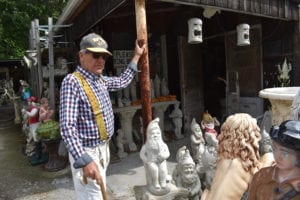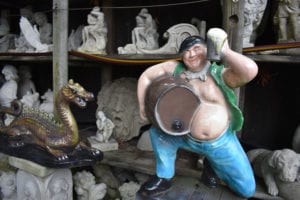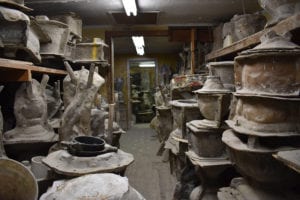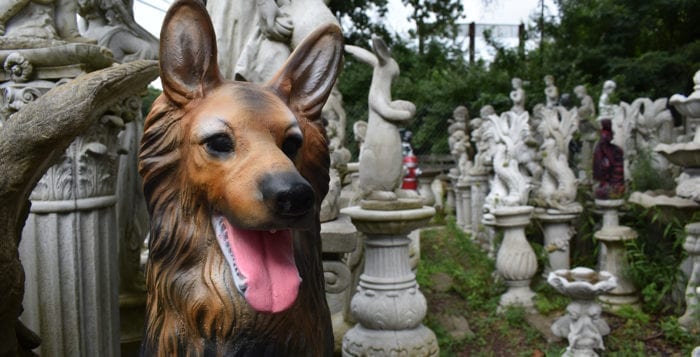Mario Tribuzio, the 87-year-old owner of Rocky Point Statuary on Route 25A, sat in his chair among gods and angels and wondered how the deer survive the winter.
“They have to drink out of people’s bird baths and they go in other people’s gardens,” Tribuzio said. “You’re tucked into a nice warm house and they’re surviving out there in the winter, rain, ice and snow. Incredible, eh? But I feel bad for the deer. The deer got to make a living too.”

Somehow, despite the cold and the frost, year after year they survive, just like the statuary. Every winter the business slows to a crawl, but every spring Tribuzio is there, in his chair, awaiting the next customer to walk through his gate.
Every weekday morning, he walks from his house, just across the street, and opens the gates to the sound of rushing traffic. Every day he gets customers who come to him saying they had driven by so many times, wondering at the hundreds of Jesus, Mary and Buddha statues out front, but having never decided to stop in.
That wonderland of monsters, gods and animals is something the old statue maker has been building since 1966, when he first opened. In the workshop there are hundreds of statue molds lying in heaps on worn wood shelves and floors. In his paint studio, really a small shed to the rear of the statuary property, Tribuzio gives attention to his own deer. They’re concrete and painted with an airbrush and a well-practiced hand. Without close scrutiny, a passing figure might think they’re real.
“That’s why I’m still around — because I’m making them, but I can’t pick up a bag of cement no more,” he said. His face grew into a smile as he commented on his waning strength. “I never knew it was so heavy — a bag of cement, it’s like they’re making them heavier today, something’s going on.”
Tribuzio got his start as a young kid, carving shapes and figures out of soap. Later, a newly married Tribuzio was driving by the property on Route 25A and saw a man was selling statues on his front lawn. He bought the property in 1966 and moved in. Later, he bought a house just across from that property and has lived there ever since. From his perch behind the chain-link fence he has seen things change, and he said he questions if there is still a desire for crafts like his.

“People are running too far too fast, the pace of living today is just too much,” Tribuzio said. “Once people entertained themselves at home doing sculpting — carving stuff.”
With the majority of his family living in Maine, most of the time he is alone, even if he remains in the company of his stone brothers and sisters.
“Even the smell of a bag of cement brings back so many memories,” Tribuzio’s daughter Marjorie Adams said. “Statue making is in his blood, and he’s been doing it his whole life.”
Though all three of Tribuzio’s children moved up to Maine, several of his children and grandchildren still take the trek south periodically to help him in his workshop and also learn the art of statue making. Tribuzio’s granddaughter Megan Tribuzio said some of her family has continued their grandfather’s trade and made a small statuary in the town of Northport, Maine.
“I’m proud of his business, and I hope there is some way to keep it open,” Tribuzio’s granddaughter said. “No matter where you are, a lot of people like those statues, whether it’s a mermaid, a dolphin or a deer, people like to have them in their yard.”

Where in earlier decades he had young people working with him to make the statues, now it’s just him. He said the liability insurance has pushed out any hope of hiring anybody new. And as he ages he finds it near impossible to lift the bags of concrete to poor into the molds. He’s contented himself by making smaller statues like his deer, or the small ornaments designed to look like bread, donuts and Italian bread real enough to eat.
David Perry, who now lives in Brentwood, worked in the statuary for nearly 25 years before heart issues forced him to stop. Tribuzio called him one of the best statue painters he ever saw, painting beautiful work on images of Jesus or Venus, back before it became too expensive to use the glossy lacquer paints.
“He was more than just a boss, he was a good friend, and he’s about the only thing that I have that resembles family anymore,” Perry said. “He’s very fair, that’s the best way to put it, he’s real old school.”
Tribuzio remains the last thread that is currently holding the statuary together, and despite the family’s desire to maintain the business it would be hard for any of them to leave Maine and take it over.
Still, the old statue maker has cement in his blood, and for now he couldn’t imagine doing anything else.
“I’m fortunate, real fortunate,” Tribuzio said. “I started out dedicated to do something like this and I can’t believe how it worked out myself.”






